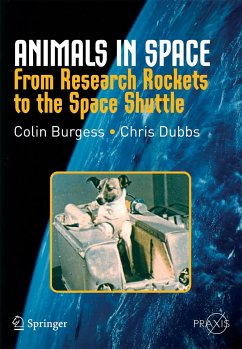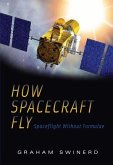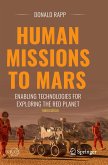Many readers will doubtless be astonished to learn that animals were being fired aloft in U.S. and Soviet research rockets in the late 1940s. In fact most people not only believe that the Russian space dog Laika was the first canine to be launched into space, but also that the high-profile, precursory Mercury flights of chimps Ham and Enos were the only primate flights conducted by the United States. In fact, both countries had sent literally dozens of animals aloft for many years prior to these events and continued to do so for many years after. Other latter-day space nations, such as France and China, would also begin to use animals in their own space research.
Animals in Space will explain why dogs, primates, mice and other rodents were chosen and tested, at a time when dedicated scientists from both space nations were determined to establish the survivability of human subjects on both ballistic and orbital space flights. It will also recount the way this happened;the secrecy involved and the methods employed, and offer an objective analysis of how the role of animals as spaceflight test subjects not only evolved, but subsequently changed over the years in response to a public outcry led by animal activists. It will explore the ways in which animal high-altitude and space flight research impacted on space flight biomedicine and technology, and how the results - both successful and disappointing - allowed human beings to then undertake that same hazardous journey with far greater understanding and confidence.
This book is intended as a detailed yet highly readable and balanced account of the history of animal space flights, and the resultant application of hard-won research to space technology and astrobiology. It will undoubtedly become the ultimate authority on animal space flights.
Animals in Space will explain why dogs, primates, mice and other rodents were chosen and tested, at a time when dedicated scientists from both space nations were determined to establish the survivability of human subjects on both ballistic and orbital space flights. It will also recount the way this happened;the secrecy involved and the methods employed, and offer an objective analysis of how the role of animals as spaceflight test subjects not only evolved, but subsequently changed over the years in response to a public outcry led by animal activists. It will explore the ways in which animal high-altitude and space flight research impacted on space flight biomedicine and technology, and how the results - both successful and disappointing - allowed human beings to then undertake that same hazardous journey with far greater understanding and confidence.
This book is intended as a detailed yet highly readable and balanced account of the history of animal space flights, and the resultant application of hard-won research to space technology and astrobiology. It will undoubtedly become the ultimate authority on animal space flights.
From the reviews:
"Animals in Space, a relentlessly factual account of animal endeavours in near Earth orbit. ... The programme and its relationship to animal rights is surely fertile material for any future popular science work on the subject. ... the history of animal space flight is long and fascinating. It deserves its place alongside the human stories of Vostok 1, Apollo 11 and Challenger." (New Scientist, April, 2007)
"Animals in Space is an extremely detailed, yet absorbing, history of animals used in the space programs around the world. ... In addition to a list of references at the end of each chapter, the book's documentation includes photos, charts, and lists of the U.S., Soviet, Chinese, French and international space missions (including Bion and International Space Station) that utilized animals as test and research subjects. ... the book will surely serve as a standard on the subject for years to come." (Advocacy for Animals, November, 2007)
"Animals in Space, a relentlessly factual account of animal endeavours in near Earth orbit. ... The programme and its relationship to animal rights is surely fertile material for any future popular science work on the subject. ... the history of animal space flight is long and fascinating. It deserves its place alongside the human stories of Vostok 1, Apollo 11 and Challenger." (New Scientist, April, 2007)
"Animals in Space is an extremely detailed, yet absorbing, history of animals used in the space programs around the world. ... In addition to a list of references at the end of each chapter, the book's documentation includes photos, charts, and lists of the U.S., Soviet, Chinese, French and international space missions (including Bion and International Space Station) that utilized animals as test and research subjects. ... the book will surely serve as a standard on the subject for years to come." (Advocacy for Animals, November, 2007)








